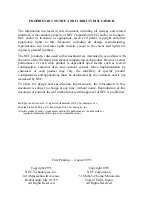
INTRODUCTION
Thank you for selecting the
2/10/15 Amp 12 Volt Smart Battery Charger.
With proper care and use, it will give you years of dependable service. This battery
charger has a high charge rate of up to 15 amps, and low charge rate of 2 amps.
It is designed for charging only 12 volt lead-acid batteries — conventional
automotive, maintenance-free, marine deep cycle and gel — used in cars, trucks,
farm equipment, boats, RVs and SUVs, lawn mowers/garden tractors, motorcycles,
personal watercraft, snowmobiles, ATVs and various applications.
Smart Battery Chargers feature 3-stage, high-efficiency charging technology, built-in
microprocessor control that ensures fast, safe and complete charging of serviceable
batteries.
Charge Curve
Stage One —
Rapid Start Charge at 15 amps delivers maximum charging
amperage to “wake up” any serviceable 12 volt battery and allows for quick engine
starting in just 3
1
⁄
2
minutes (based on a midsize vehicle battery at 50% charge level).
When battery reaches a maximum safe predetermined voltage, the charger will
automatically signal a "beep" and move into Stage 2 of the charging process.
Stage Two —
Absorption Charge maintains the maximum possible charge at a
constant, safe, predetermined voltage. During this phase, the charging voltage remains
constant, while the actual charging current is reduced to allow for the maximum proper
STAGE ONE
BEEP
BEEP
OFF BEEP
STAGE TWO
STAGE THREE
CHARGING
COMPLETE
LED LIT
4. Determine which post of battery is grounded (connected) to the chassis. If NEGATIVE post is
grounded to chassis (as in most vehicles), see 5. If POSITIVE post is grounded to the chassis, see 6.
5. For negative-grounded vehicle, connect POSITIVE (RED) clamp from battery charger to POSITIVE
(POS, P, +) ungrounded post of battery. Connect NEGATIVE (BLACK) clamp to vehicle chassis or
engine block away from battery. Do not connect clip to carburetor, fuel lines, or sheet-metal body
parts. Connect to heavy gauge metal part of the frame or engine block.
6. For positive-grounded vehicle, connect NEGATIVE (BLACK) clamp from battery charger to
NEGATIVE (NEG, N, –) ungrounded post of battery. Connect POSITIVE (RED) clamp to vehicle
chassis or engine block away from battery. Do not connect clip to carburetor, fuel lines or sheet-
metal body parts. Connect to a heavy gauge metal part of the frame or engine block.
7. When disconnecting charger, disconnect AC cord, remove clamp from vehicle chassis, and then
remove clamp from battery terminal.
8. Do not charge the battery while the engine is operating.
9. See operating instructions for length of charge information.
Follow these steps when the battery has been removed from a vehicle. A spark near
the battery may cause an explosion. To reduce risk of a spark near the battery:
1. Check polarity of battery posts, the Positive posts (marked POS,P, +) usually has a larger diameter
than the Negative battery post (marked NEG, N, –).
2. Attach a 24-inch (minimum length) 6 AWG insulated battery cable to the Negative battery post
(marked NEG, N, –).
3. Connect the Positive (RED) battery clamp to the Positive battery post (marked POS, P, + or red).
4. Stand as far back from the battery as possible, and do not face battery when making final
connection.
5. Carefully connect the NEGATIVE (BLACK) charger clamp to the free end of the battery cable
connected to the negative terminal.
6. Set the charge rate to appropriate setting according to battery size.
7. When disconnecting charger, always do so in reverse sequence of connecting procedure and break
first connection while as far away from battery as practical.
Note:
A marine (boat) battery must be removed and charged on shore. To charge it
on board requires equipment specially designed for marine use. This unit is
NOT designed for such use.
SAVE THESE INSTRUCTIONS
This device complies with part 15 of the FCC rules. Operation is subject to
the following two conditions: (1) this device may not cause harmful
interference, and (2) this device must accept any interference received,
including interference that may cause undesired operation.
This equipment has been tested and found to comply with the limits for a
Class B digital device, pursuant to part 15 of the FCC Rules. This limits are
designed to provide reasonable protection against harmful interference in a
residential installation. This equipment generates, uses and can radiate radio
frequency energy and, if not installed and used in accordance with the
instructions, may cause harmful interference to radio communications.
However, there is no guarantee that interference will not occur in a particular
installation. If equipment does cause harmful interference to radio or
television reception, which can be determined by turning the equipment off
and on, the user is encouraged to try to correct the interference by one or
more of the following measures:
• Reorient or relocate the receiving antenna.
• Increase the separation between equipment and receiver.
• Connect the equipment into an outlet on a circuit different from that to
which the receiver is connected.
• Consult the dealer or an experienced radio/TV technician for help.

























